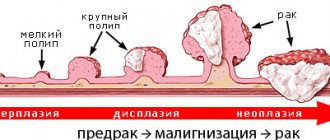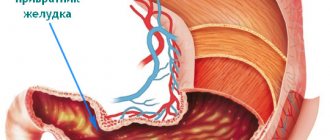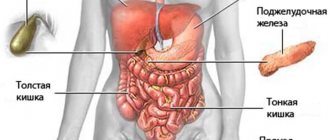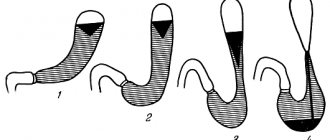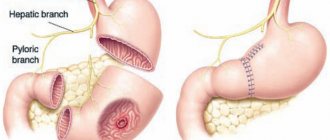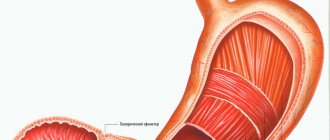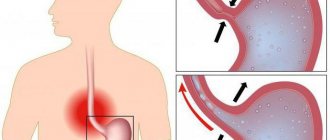What is a stomach?
The name "stomach" is given to the hollow muscular organ that is a vital part of the digestive system.
The esophagus is adjacent to it on one side, and the duodenum on the other. It is shaped like a bag, which expands as water and food enter. An empty stomach has a volume of about half a liter (for overweight people - up to one and a half). Usually, after eating, its volume increases to a liter, however, if necessary, it can accommodate all four liters. But one should not think that the stomach performs a storage function. It simply digests food as the body needs it, but reserves are deposited in tissues in the form of fats, carbohydrates and proteins.
The hollow space in the digestive system resembles a bag. This is the stomach, which serves as a connection above the esophagus and below the duodenum. It consists of several sections, performs numerous functions, and contributes to the normal functioning of the body.
After food enters the mouth, a person chews it thoroughly and swallows it. It goes down into the stomach. It accumulates there and is partially digested under the influence of hydrochloric acid and special enzymes. They are necessary for the breakdown of proteins and fats. The food then moves through the gastrointestinal tract.
Organ structure
Structure of the stomach
The digestive system supports human life. The stomach occupies a special place in its structure. It contains muscle fibers and has high elastic qualities. Can stretch several times its original volume. It starts from the esophagus and runs to the duodenum.
There are sphincters in the lower and upper parts of the organ. We are talking about the cardinal and pyloric elements. The main process of digestion occurs in the sections of the stomach. Products entering there are partially broken down and continue to move to other organs located below.
According to anatomy, the stomach consists of two walls. There are anterior and posterior interlocking surfaces. The edges of the organ form the greater and lesser curvature of the stomach. When a person eats food, he becomes full. The greater curvature of the stomach in this situation is at the level of the navel.
The inner lining of the organ contains the mucous membrane. It is necessary for the formation of enzymes involved in the digestion process. Beneath the mucous membrane there is a muscular layer. On the outside there is a serous coating.
In the gastrointestinal tract, food accumulates, mixes, and is partially broken down. The stomach performs many other functional duties:
- preserves food;
- controls basal secretion of gastric juice;
- carries out chemical processing of food;
- promotes the movement of food and timely emptying;
- through it nutrients are absorbed into the blood;
- has a bactericidal effect;
- performs protective functions.
During the digestion process, all metabolic products are eliminated. The same applies to substances that have a negative effect on the functioning of the endocrine glands.
Departments
The gastrointestinal tract consists of several parts. Each department performs a specific function and takes part in the process of digesting food.
Cardiac. The department is located next to the heart, which is why it got its name. This is the border between the esophagus and the stomach, where the cardiac sphincter is located. It consists of muscle fibers. The pulp prevents food from entering the esophagus area.
Gastrointestinal tract
Fundus of the stomach. A section that is located at the level of the esophagus. Externally it looks like a dome. It is called the bottom (vault). This part collects air, which enters the digestive organ along with food. The mucous membrane of the fundus contains a large number of glands that secrete hydrochloric acid. It is necessary for digesting food.
Body. The main and largest part of the digestive organ. Its beginning lies in the cardiac region and ends in the pyloric part. The absorbed food collects in the body.
Pyloric department. The area, which is also called the gatekeeper. It is located below all departments. After the pyloric region, the small intestine begins. It includes a canal and a cave. These two areas also perform certain functions. The canal facilitates the movement of food from the stomach to the duodenum. The cave preserves partially digested food.
All parts of the stomach support the proper functioning of the digestive system. Each area requires a certain amount of time to function. Fruit juices or broths are digested for 20 minutes. Meat dishes require 6 hours.
Table for calculating digestion time for certain types of foods you eat
The human stomach works under the influence of certain factors. External sources include the feeling of hunger, touch, vision, and sensations. The internal factor is the digestion process.
It all starts from the moment food enters the oral cavity. It is mixed with saliva and chewed. Swallowing movements contribute to its movement into the esophagus. Under the influence of the sphincter, it moves to the main organ of digestion - the stomach.
There are several stages of food processing.
Diagram of the human digestive system
Storage. The walls of the digestive organ relax to stretch and accommodate more food.
Mixing. The lower part of the organ contracts, which leads to mixing of its contents. Gastric enzyme, hydrochloric acid, and protein digestors help digest food. The additional cell membrane maintains a protective layer of the walls of the digestive organ by secreting a certain amount of mucus.
Emptying. After mixing, the food moves to the upper small intestine area. This is where the chemical process of fat breakdown takes place. Intestinal enzymes and pancreatic secretion take part in it.
Gastric juice has a detrimental effect on numerous pathogens due to its bactericidal properties. Sometimes pathogens of various diseases enter the digestive system with low-quality products. Gastric juice also contains mucin, a mucous substance that protects the walls of the digestive organ from self-digestion.
It is possible to prevent gastric pathologies. It is enough to maintain the complex mechanism of the digestion process. A person’s vital functions may be disrupted if nutrients are no longer absorbed. Experts recommend remembering some useful tips to support the proper digestive process:
- protect the stomach from injury;
- Avoid drinking raw tap water;
- adhere to simple rules of hygiene, maintain a healthy oral cavity;
- take walks in the fresh air every day;
- maintain a nightly rest routine;
- Take medications strictly after consulting a doctor.
When we talk about preventing digestive disorders, we should not forget about proper nutrition. Eating nutritious food keeps the body healthy. A person should adhere to a healthy, regular and varied diet. Such simple rules will help maintain the health of the digestive system, prevent failures and gastric pathologies.
It is important to monitor the condition of your stomach in order to promptly seek help from specialists. Knowledge of its structure and functioning will help maintain the healthy functioning of the organ.
https://youtu.be/WLyaQmbVhw4
Diagnostic methods
Diagnosis of pathology begins with collecting anamnesis. At the appointment, the doctor examines the patient:
- assesses the condition of his skin (with gastritis, the skin is dry);
- presence of bleeding gums;
- white or gray coating on the tongue.
The patient talks about what symptoms he is experiencing, the doctor finds out the hereditary factor, adherence to healthy eating rules, and concomitant pathologies.
Then the patient is prescribed laboratory tests:
- clinical blood test (during the disease, the concentration of red blood cells, leukocytes, platelets and hemoglobin is reduced);
- An antibody test in the blood can reveal a dysfunction of the immune system;
- a biochemical blood test is necessary to detect pathologies of other organs of the digestive system.
Functional or instrumental diagnostics allow a more accurate diagnosis.
- The most reliable method of examination is gastroscopy; it makes it possible to notice foci of damage to the mucosa, localized in the lower part of the stomach, and reduced peristalsis. During gastroscopy, the doctor can perform tissue sampling for histological examination, as well as ph-metry of gastric juice.
- Atrophy of the folds of the stomach can also be detected by performing fluoroscopy with contrast (barium). But this method is several times inferior to gastroscopy in terms of the degree of information content and reliability of the data.
Types and functions of gastric glands
The total number of gastric glands in a healthy adult patient reaches 15 million. Below is their main classification, which is used by gastroenterologists.
Own glands
This group includes glands that are located in the body or bottom. Quantitatively, they significantly prevail over all others. In the mucous membrane there are groups of 2-8 glands, which open into small depressions - pits. They consist of several parts: a narrow neck, an elongated body and a bottom. Contains five types of secretory cells:
- The chief cells of the stomach are the most numerous. They are distinguished by basophilic granularity and a large nucleus. The cytoplasm contains molecules of proenzymes that are in an inactive form. Their activation occurs directly in the stomach cavity. The chief cells of the stomach produce pepsinogen, gastrixin, chymosin and gastric lipase.
- Parietal (lining) cells of the stomach - the largest number of them are located in the bottom of the organ. They are round and much larger than the main ones. They have oxyphilic cytoplasm. The parietal cells of the stomach glands produce hydrochloric acid. They have specific channels on the membrane for Hydrogen ions, which allows them to capture them and use them for metabolic processes.
- Mucous cells are located in the neck of the glands. There are much fewer of them. They are now considered to be a "reserve". If necessary, they migrate to the body or bottom of the gland, where they develop into full-fledged parietal or chief cells.
- Endocrine cells are located mainly at the bottom of the glands. Inside them in the cytoplasm there are secretory granules, which, if necessary, rise to the apical membrane. Produce histamine, somatostatin, serotonin, motilin, substance P.
Pyloric glands
The pyloric glands are located in the same section of the stomach. They are tubular and have curved ends. Their significance is to reduce the acidity of gastric contents before they enter the duodenum. Therefore, parietal cells are completely absent here, and the main cells are represented in small quantities.
The pyloric glands secrete bicarbonates - alkaline salts, as well as large amounts of mucus. Additionally, somatostatin, serotonin, motilin, substance P and enteroglucagon are produced by endocrine cells.
Cardiac glands
They are located in the cardiac part of the stomach. Morphologically and functionally they are analogues of the glands that are located in the esophagus. Characterized by highly developed ducts. They consist mainly of mucous cells that produce mucus, as well as a significant amount of salts (mainly bicarbonates). Parietal and head cells are found here in small quantities, so the acidity in this part of the stomach is much lower than in the body.
Endocrine glands
The endocrine glands, which are located in the stomach, belong to the APUD system. It unites various endocrine cells that are located in the epithelium of the human digestive and respiratory system. It consists of specific cells - apudocytes, which produce glandular hormones (small molecules of protein origin).
The largest number of endocrine cells is located in the body and pylorus of the stomach.
The biologically active molecules they produce take part in regulating the functioning of the digestive system:
- gastrin – activates the production of pepsin, hydrochloric acid, increases acidity in the stomach;
- somatostatin – growth hormone;
- histamine – stimulates the secretion of gastric juice, is one of the most important protective mediators of the mucous membrane;
- substance P – increases motor activity and peristalsis of the stomach and postbulbar intestine;
- serotonin – regulates the motility of the digestive system, bile production;
- enteroglucagon – activates glycogenolysis processes in the liver.
Causes
The exact reasons for the development of submucosal tumors both in the cardiac and in any other part of the stomach are unknown. However, there are several factors that, according to doctors, can provoke this pathological process:
- Peptic ulcer and gastritis.
- Helicobacter pylori infection.
- Hereditary predisposition.
- Unbalanced diet.
- Exposure to chemicals on the body.
- Smoking and alcohol abuse.
The appearance of neoplasms is typical for patients over 40 years of age. Oncopathology is usually discovered by chance during endoscopy. If the carcinoma has grown greatly, the patient may complain of nausea and vomiting, constipation, and aching pain. Leiomyomas in the cardiac part of the stomach can provoke bleeding, which leads to anemia.
Treatment options
The antrum of the stomach (located above the rectum) is treated with an individual course of therapy, which is aimed at stopping and eliminating symptomatic manifestations. Treatment is carried out in two directions: conservative (medicines, physiotherapy) and the appointment of surgical intervention.
Drug therapy for diseases of the antrum is a long process that is always complex. During the treatment period, certain measures are prescribed in the form of changes in diet and giving up bad habits. Based on the result of therapy, the doctor decides whether to make such recommendations.
Treatment with medications involves the use of several groups of drugs at once. The main ones are described in the table below, including detailed descriptions and names.
| Group | Titles | Description and effect on the body |
| Proton pump inhibitors | Omeprazole, Rabeprazole, Omez, Dexlansoprazole, Metronidazole, Pantoprazole, Controloc | Intended for the treatment and prevention of acid-dependent pathologies of the stomach. Eliminates excess production of hydrochloric acid. |
| Enveloping agents | Phosphalugel, Aluminum hydroxide, Maalox, Sucralfate | Absorbent antacid preparations, which help protect the inner walls of the stomach from exposure to an acidic environment. They also have a significant analgesic effect. Side effects: dry mouth, itching and drowsiness. |
| Gastroprotectors | Almagel, Pilorid, Denol | Promote rapid restoration of the gastric mucosa and increased blood flow in tissues and blood vessels. Due to side effects such as nausea, bloating and rash, it is not recommended for children and adolescents. |
Depending on other signs of the disease, the doctor prescribes symptomatic remedies that quickly relieve negative complications.
These include antispasmodics, sedatives and antiemetics.
Probiotics and enzymes may also be used. Vitamin complexes and immunomodulators are often used.
The average duration of drug treatment is from 1 to 2 months.
If the pathological processes are chronic, therapy is prescribed for life or during exacerbations. In some cases, doctors may resort to surgery.
These include: low effectiveness of drug therapy, increased bleeding, the presence of cancer and polyps. The easiest surgical method is endovasal laser coagulation, which can reduce inflammatory reactions, eliminate bleeding or remove formed polyps without the risk of complications.
Due to the lack of evidence, folk remedies for treatment are practically not used and can be prescribed as an additional measure under the direct advice of the treating specialist.
Since almost all stomach diseases are caused by an unhealthy lifestyle, drug therapy is not enough. In addition to treatment, the doctor prescribes a number of preventive measures to improve the patient’s condition.
Step-by-step recommendations for preventing and maintaining stomach health:
- Introduce a balanced diet: eliminate absolutely all unhealthy foods, including fried, fatty or spicy foods; give up carbonated drinks and strong coffee; avoid simple carbohydrates. Add as many vegetables and fruits as possible to your daily diet and eat only lean meats and fish.
- Give up bad habits: smoking, drinking alcohol or taking hard drugs or psychopathic drugs. This also includes thoughtless taking of medications.
- Avoid stressful and psycho-emotional situations, achieve maximum physical peace through meditative practices and frequent walks in the fresh air. Eliminate excess weight.
- If you have any symptoms, visit your doctor promptly and undergo an annual medical examination. Periodic testing for the presence of Helicobacter Pylori is mandatory.
Detailed adherence to the recommendations described above will significantly reduce the risk of severe gastric diseases, and simple adherence to dietary standards will relieve unwanted weight.
The antrum is an important part of the stomach, responsible for the process of grinding and pushing consumed food through the outlet sphincter. A correct understanding of where the antrum is located, as well as timely diagnosis of diseases, will allow you to avoid dangerous consequences in the form of cancer or inflammation.
With a correctly selected and timely treatment method, you can quickly get rid of pathological processes.
Article design: Oleg Lozinsky
Consequences of overeating
If the diet is not followed, with systematic overeating, snacking on heavy, hard-to-digest food, the stomach cavity stretches, and the muscle structures cease to provide the necessary contraction. A distended stomach in a person negatively affects human health, leading to the following complications:
- increase in body weight, up to the development of obesity;
- difficulty breathing (due to compression of the pulmonary structures);
- chronic tachycardia (complication of cardiac history);
- slowing down blood flow to the spleen (provokes the desire to sleep);
- hepatic colic (due to compression of the liver on the right).
With systematic overeating and compression of internal organs, the intestines also suffer. Food masses are pressed, petrified, and prevent deposition and passage to the rectum. Hence constipation, weight gain, mild intoxication of the body, and poor health. The volume of food at one time should not exceed 0.5 liters. Therapeutic nutritional methods include fractional meals of 300 ml per serving.
Fast food and snacks
Modern gastroenterology and surgery can solve a number of problems with a distended stomach. To reduce the volume, surgical resection (gastroplasty) is often used. Indications for surgery may include dysfunction of vital organs, poor health, life-threatening heart complications, excess weight (including the late stages of obesity), and diabetes mellitus.
Existing methods of practical medicine in the field of dietetics and physical therapy make it possible to restore the previous muscle tone of the stomach cavity, speed up digestive processes, and improve the health of the body of a patient of any age. Following a healthy lifestyle and simple recommendations from doctors, patients achieve good therapeutic results: weight loss, blood pressure and cardiac activity normalize, and the overall quality of life increases.
But perhaps it would be more correct to treat not the effect, but the cause?
We recommend reading the story of Olga Kirovtseva, how she cured her stomach... Read the article >>
Article rating:
(votes:
, average rating:
out of 5)
All materials on the website ozhivote.ru are presented for informational purposes only, contraindications are possible, consultation with a doctor is MANDATORY! Do not engage in self-diagnosis and self-medication!
The stomach is a hollow organ, consisting of muscle tissue on the outside and complex mucous membranes on the inside, and is a kind of reservoir for the food eaten. This is where the first stage of food digestion occurs. This organ is located directly under the diaphragm, between the esophagus and duodenum...
